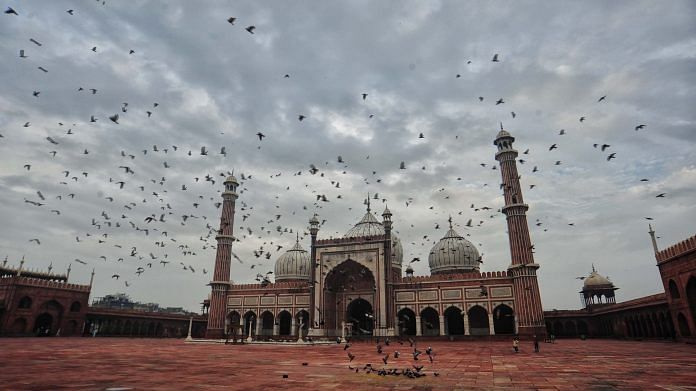Any conversation on the Anglo Arabic School is rarely possible without situating it in the context of the walled city of Delhi and the partition of its people. Muslims of the Indian subcontinent awoke to freedom in 1947 by being partitioned across borders. Along with the physical partition the country was subjected to, the Muslim community of erstwhile India was severely divided along emotional, social, and family lines affecting the Muslims of Delhi very problematically. Repercussions of which continue even till this day, and ominously perhaps will continue for future generations.
Families were suddenly sent into a state of disarray. Households were split up with some members leaving for Pakistan while others chose to stay back or were forced to stay back. Parting as it was painful also disrupted normal life for many. Poets and writers lamented the loss. The agony, writes Mushirul Hasan, was shared on both sides of the border. ‘Some longed for Lahore’s inclusion; others wished that the partition line in Punjab would be drawn below Delhi’. For Begum Shaista Ikramullah, ‘a Pakistan without Delhi was a body without a heart.’ When a question was posed by her sister-in-law Dina, ‘Do you think you will get Delhi if Pakistan is established?’ Begum Ikramullah writes,
My husband replied pointing out to the domed and turreted skyline of Delhi. ‘Look at it—whom do you think it seems to belong to?’ and Dina could not deny that the essentially Muslim character of its architecture seemed to proclaim that Delhi belonged to the Muslims. And so it did, in every way . . . But by dividing Punjab, our overall majority was lost, so we lost Delhi. And today its mosques and minarets join the mosques and minarets of Cordoba and Grenada in saying: The descendants of Arabs, they were, those who created me. I stand here, a memorial to their vanished glory.
For Begum Shaista Ikramullah Delhi was, ‘synonymous with Muslim culture’.
Delhi ‘Musalmanon ka shahar tha’. It was a ‘Muslim’ city; ‘built by Muslim rulers, full of grand Mughal monuments, and dominated by the Mughal aristocracy.’The position of Delhi in the eventuality of Pakistan was debated even before the Partition actually took place in 1947. Even as people wondered whether Delhi would form part of Pakistan, many were sure that Delhi could not be separated from the Dilliwalas. ‘Well, where else could Delhi go? Delhi is where the Dilliwallas are . . . . You just wait and see. What mother’s son can sever Delhi from the Dilliwallas—like two hearts within a single body?’
Also read:
For Shahid Ahmad Dehlavi—Delhi was his home, his city, his ‘vatan’. Separating the people of Delhi from the city was like ‘nails being pulled of the flesh’. Devotees too were in a state of anguish. Would Pakistan have its share of masjids, imambaras, and dargahs? ‘Pakistan’s existence had not diminished their devotion.’ There was also talk of Delhi becoming the joint capital of Hindustan and Pakistan. It was unimaginable that Delhi, a seat of Muslim rule and culture for centuries, could go exclusively to Hindustan. Delhi was indeed a Muslim city with the Red Fort, the Jama Masjid, the Qutub Minar, Firoz Shah Kotla, the Purana Qila and the dargahs, shrines, and mausoleums scattered around the city.
Partition also became ‘an organizing principle on which a variety of exclusions and inclusions were based’. Partition also had ‘far-reaching sociological implications for communal patterns, generational dynamics and individual life courses’. Hasan writes, ‘One can hardly fault the nostalgic strain in people’s memories, for they invariably recaptured a moment in their lives and invoked friends and places to recreate their past.’
15 August 1947, came to symbolize different meanings to different people. According to Maria Misra, while independence was something to celebrate as an achievement of democracy, ‘the celebrations themselves could not entirely efface the manifest divisions and controversies that underlay the meaning of Independence and the intended character of the new Indian state’. While Muslims celebrated with apprehension, nationalist Muslims saw partition as a betrayal of the ideals of a secular India.
It affected the likes of Maulana Azad, whose face during the celebrations, it was commented, ‘reflected the tragedy of partition’. Other Muslims, writes Misra, ‘objected to what they saw as Hindu triumphalism in the choice of the Mughal Red Fort as a venue for the celebrations. Potent symbolism was at play here: it was doubtless intended to underscore the continuity and legitimacy of the new Indian state from Mughal rather than British predecessors.’ This was in reference to 16 August 1947, when Nehru appeared at the Red Fort and where a crowd of over a million people had turned out to see him ‘raise the new flag over the seventeenth-century Mughal citadel.’
 This excerpt from Azra Razzack and M. Atyab Siddiqui’s ‘The School at Ajmeri Gate: Delhi’s Educational Legacy’ has been published with permission from Oxford University Press.
This excerpt from Azra Razzack and M. Atyab Siddiqui’s ‘The School at Ajmeri Gate: Delhi’s Educational Legacy’ has been published with permission from Oxford University Press.



